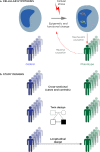Epigenome-wide Association Studies and the Interpretation of Disease -Omics
- PMID: 27336614
- PMCID: PMC4919098
- DOI: 10.1371/journal.pgen.1006105
Epigenome-wide Association Studies and the Interpretation of Disease -Omics
Abstract
Epigenome-wide association studies represent one means of applying genome-wide assays to identify molecular events that could be associated with human phenotypes. The epigenome is especially intriguing as a target for study, as epigenetic regulatory processes are, by definition, heritable from parent to daughter cells and are found to have transcriptional regulatory properties. As such, the epigenome is an attractive candidate for mediating long-term responses to cellular stimuli, such as environmental effects modifying disease risk. Such epigenomic studies represent a broader category of disease -omics, which suffer from multiple problems in design and execution that severely limit their interpretability. Here we define many of the problems with current epigenomic studies and propose solutions that can be applied to allow this and other disease -omics studies to achieve their potential for generating valuable insights.
Conflict of interest statement
I have read the journal's policy and have the following conflicts: EB is a paid consultant and option holder in Oxford Nanopore Technologies, a company making DNA sequencing devices.
Figures

References
Publication types
MeSH terms
Grants and funding
LinkOut - more resources
Full Text Sources
Other Literature Sources
Research Materials

